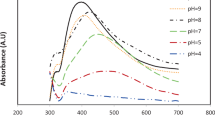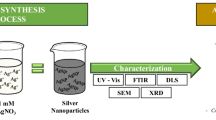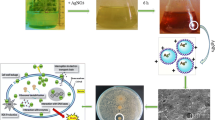Abstract
In this work, the biosynthesis of silver nanoparticles by Galega officinalis extract using AgNO3 as a precursor was reported. The reaction parameters for the biosynthesis and efficiency in their antimicrobial control against Escherichia coli, Staphylococcus aureus and Pseudomonas syringae were determined. For biosynthesis, a central composite design combined with response surface methodology was used to optimize the process parameters (pH, AgNO3 and extract concentration), and the design was assessed through the size distribution, zeta potential and polydispersity index of the nanoparticles. The results demonstrated that at pH 11, 1.6 mM of AgNO3 and 15% vv−1 of G. officinalis extract were the optimal reaction parameters. Transmission electron microscope (TEM) images and X-ray diffraction (XRD) confirmed the formation of small spherical silver nanoparticles. Antimicrobial assays showed a high inhibitory effect against E. coli, S. aureus and P. syringae, and that effect was larger with silver nanoparticles of a smaller size (23 nm). This work demonstrates that G. officinalis extract is a feasible medium for the synthesis of silver nanoparticles and that the control of the reaction parameters can determine the nanoparticle characteristics and therefore their antimicrobial effectiveness.
Graphical abstract





Similar content being viewed by others
References
Ali M, Kim BD, Belfield K, Norman D, Brennan M, Ali GS (2016) Green synthesis and characterization of silver nanoparticles using Artemisia absinthium aqueous extract—A comprehensive study. Mater Sci Eng C 58:359–365
Aziz W, Jassim HA (2018) A novel study of pH influence on Ag nanoparticles size with antibacterial and antifungal activity using green synthesis. World Sci News 97:139–152
Baker C, Pradhan A, Pakstis L, Pochan DJ, Shah SI (2005) Synthesis and antibacterial properties of silver nanoparticles. J Nanosci Nanotechnol 5:244–249
Chamakura K, Perez-Ballestero R, Luo Z, Bashir S, Liu J (2011) Comparison of bactericidal activities of silver nanoparticles with common chemical disinfectants. Colloids Surf B 84:88–96
Champavier Y, Allais DP, Chulia AJ, Kaouadji M (2000) Acetylated and non-acetylated flavonol triglycosides from Galega officinalis. Chem Pharm Bull 48:281–282
de Aragǎo AP, de Oliveira TM, Quelemes PV, Gomes PML, Carvalho AM, Sousa JAS, Cardoso VN, Quaresma P, de Souza JRAL, Alves DS (2016) Green synthesis of silver nanoparticles using the seaweed Gracilaria birdiae and their antibacterial activity. Arab J Chem. https://doi.org/10.1016/j.arabjc.2016.04.014
Dong C, Chuanliang C, Zhang X, Zhang Y, Wang X, Yang X, Zhou K, Xiao X, Yuan B (2017) Wolfberry fruit (Lycium barbarum) extract mediated novel route for the green synthesis of silver nanoparticles. Optik 130:162–170
Durán N, Marcato PD, De Souza GIH, Alves OL, Esposito E (2007) Antibacterial effect of silver nanoparticles produced by fungal process on textile fabrics and their effluent treatment. J Biomed Nanotechnol 3:203–208
Durán N, Durán M, de Jesus MB, Seabra AB, Fávaro WJ, Nakazato G (2016) Silver nanoparticles: a new view on mechanistic aspects on antimicrobial activity. Nanomed Nanotechnol Biol Med 12:789–799
Dzul-Erose MS, Cauich-Díaz MM, Raso-Lazcano TA, Avila-Rodriguez M, Reyes-Aguilera JA, González-Muñoz MP (2018) Aqueous leaf extracts of Cnidoscolus chayamansa (Mayan chaya) cultivated in Yucatán México Part II: uses for the phytomediated synthesis of silver nanoparticles. Mater Sci Eng C 91:838–852
Feng HL, Gao XY, Zhang ZY, Ma JM (2010) Study on the crystalline structure and thermal stability of silver oxide films deposited by direct-current reactive magnetron sputtering methods. J Korean Phys Soc 56:1176–1179
Gericke M, Pinches A (2006) Biological synthesis of metal nanoparticles. Hydrometallurgy 83:132–140
Guan X, Yao H (2008) Optimization of Viscozyme L-assisted extraction of oat bran protein using response surface methodology. Food Chem 106:345–351
Hamouda T, Baker JR (2000) Antimicrobial mechanism of action of surfactant lipid preparations in enteric Gram-negative bacilli. J Appl Microbiol 89:397–403
Khalil MMH, Ismail EH, El-Baghdady KZ, Mohamed D (2014) Green synthesis of silver nanoparticles using olive leaf extract and its antibacterial activity. Arab J Chem 7:1131–1139
Luka CD, Omoniwa BP (2012) Effect of some phytochemicals extracted from goat’s rue (Galega officinalis) on some biochemical parameters in normal and alloxan-induced diabetic rats. J Nat Prod Plant Resour 2:628–632
Mafuné F, Kohno J, Takeda Y, Kondow T, Sawabe H (2000) Formation and size control of silver nanoparticles by laser ablation in aqueous solution. J Phys Chem B 104:9111–9117
Makarov VV, Love AJ, Sinitsyn OV, Makarova SS, Yaminsky IV, Taliansky ME, Kalinina NO (2014) Green nanotechnologies: synthesis of metal nanoparticles using plants. Acta Naturae 6:35–44
Mittal AK, Chisti Y, Banerjee UC (2013) Synthesis of metallic nanoparticles using plant extracts. Biotechnol Adv 31:346–356
Muller RH, Heinemann S (1992) Fat emulsions for parenteral nutrition. I. Evaluation of microscopic and laser light scattering methods for the determination of the physical stability. Clin Nutr 11:223–236
Neelgund GM, Karthikeyan B, Shivashankar SA, Oki A (2015) Single-step, size-controlled synthesis of colloidal silver nanoparticles stabilized by octadecylamine. Appl Surf Sci 356:726–731
Pallela PNVK, Ummey S, Ruddaraju LK, Pammi SVN, Yoon SG (2018) Ultra small, mono dispersed green synthesized silver nanoparticles using aqueous extract of Sida cordifolia plant and investigation of antibacterial activity. Microb Pathog 124:63–69
Panáček A, Smékalová M, Večeřová R, Bogdanová K, Röderová M, Kolář M, Kilianová M, Hradilová S, Froning JP, Havrdová M, Prucek R, Zbořil R, Kvítek L (2016) Silver nanoparticles strongly enhance and restore bactericidal activity of inactive antibiotics against multiresistant Enterobacteriaceae. Colloid Surf B 142:392–399
Ramteke C, Chakrabarti T, Sarangi BK, Pandey RA (2013) Synthesis of silver nanoparticles from the aqueous extract of leaves of Ocimum sanctum for enhanced antibacterial activity. J Chem 2013:1–7
Sathishkumar M, Sneha K, Won SW, Cho CW, Kim S, Yun YS (2009) Cinnamon zeylanicum bark extract and powder mediated green synthesis of nano-crystalline silver particles and its bactericidal activity. Colloids Surf B Biointerfaces 73:332–338
Slepička P, Elashnikov R, Ulbrich P, Staszek M, Kolská Z, Švorčík V (2015) Stabilization of sputtered gold and silver nanoparticles in PEG colloid solutions. J Nanopart Res 17:11
Uvarov V, Popov I (2013) Metrological characterization of X-ray diffraction methods at different acquisition geometries for determination of crystallite size in nano-scale materials. Mater Charact 85:111–123
Vanaja M, Annadurai G (2013) Coleus aromaticus leaf extract mediated synthesis of silver nanoparticles and its bactericidal activity. Appl Nanosci 3:217–223
Velgososvá O, Mražíková A, Marcinčá R (2016) Influence of pH on green synthesis of Ag nanoparticles. Mater Lett 180:336–339
Wiegand I, Hilpert K, Hancock RE (2008) Agar and broth dilution methods to determine the minimal inhibitory concentration (MIC) of antimicrobial substances. Nat Prot 3:163–175
Acknowledgements
This works was financed by FONDECYT (Project Nos. 1130854 and 1161713), REDES-CONICYT 180003, MEC-CONICYT 80170089 and 80170096, CONICYT/FONDAP/15130015 and Vicerrectoría de Investigación y Postgrado UFRO DI17-1002 and DI17-2015.
Author information
Authors and Affiliations
Corresponding author
Additional information
Publisher's Note
Springer Nature remains neutral with regard to jurisdictional claims in published maps and institutional affiliations.
Rights and permissions
About this article
Cite this article
Manosalva, N., Tortella, G., Cristina Diez, M. et al. Green synthesis of silver nanoparticles: effect of synthesis reaction parameters on antimicrobial activity. World J Microbiol Biotechnol 35, 88 (2019). https://doi.org/10.1007/s11274-019-2664-3
Received:
Accepted:
Published:
DOI: https://doi.org/10.1007/s11274-019-2664-3




